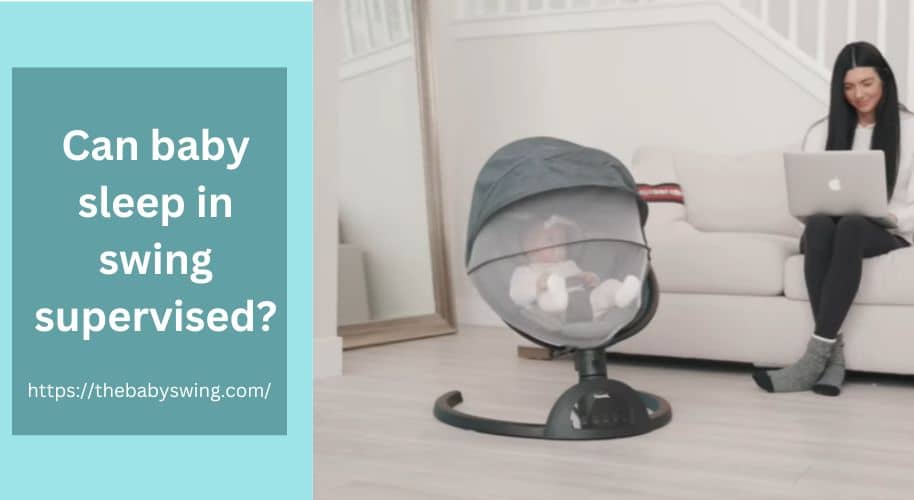Last Updated on July 20, 2023
It is not recommended to let your baby sleep in a swing, even when supervised. According to the American Academy of Pediatrics (AAP), swings are meant for recreational use only and should not be used for sleeping infants.
Babies have not developed enough muscles to hold up their heads, which can lead to positional asphyxiation. It is better to transfer a sleeping baby from the swing into a crib or bassinet.
In this article, we’ll discuss the risks associated with leaving a baby to sleep in a swing and suggest safer ways of getting your baby to sleep. So, keep reading!

Can baby sleep in swing supervised?
As mentioned above, it is generally not recommended for babies to sleep in a swing, as it can be unsafe. However, if you are supervising your baby while they are in the swing, then it may be okay for them to take a short nap.
But you have to ensure that your baby is strapped in tightly and you are in the same room as them at all times.
“The AAP recommends that you never leave your baby unattended in any kind of infant seat, such as a swing or a car seat,” says Dr. Alisa Baer, a board-certified pediatrician, nationally certified child passenger safety instructor.
She emphasizes, “even if it is supervised, you shouldn’t let your baby sleep in a swing. After all, the baby’s safety comes first.”
If your baby gets used to falling asleep in the swing, it could be difficult to break this habit and transition them into a crib or bassinet.
However, a little patience and consistency will be key when it comes to getting your baby to sleep in a safe environment.
Watch this video on Is it safe for my baby to sleep in a swing
Also read: Is baby swing safe for babies
Can baby sleep in swing during the day?
No, a baby should not sleep in a swing during the day or night. According to the American Academy of Pediatrics (AAP), swings are not safe for overnight sleep or even napping.
Infants should use swings recreationally while under a caretaker’s supervision and should never use them as a substitute for a crib or bassinet.
They should use swings or similar devices when they are awake in the daytime.
“Infant swings should be used for no more than 30 minutes at a time and an hour in total as overusing could cause overstimulation,” says Dr. Alisa.
It is not advisable to let your baby take a nap in the swing because most swings have elevated seats, which are not considered safe sleeping positions for babies.
If they fall asleep while in the swing, their head might slump forward and impede their airflow or even cause breathing difficulties.
Additionally, using baby swings as beds has been linked to Sudden Infant Death Syndrome (SIDS), so it’s better to avoid having them sleep in the swing altogether, explains Alisa.
She adds that parents should also be aware of other dangers associated with swings, such as the possibility of falls and entrapment.
Therefore, you should follow the AAP’s guidelines for the safe use of infant swings and not let your baby sleep in a swing during the day or night.
Also read: How to make your baby sleep without swing
Can a baby get SIDS from sleeping in a swing?
Sudden Infant Death Syndrome (SIDS) is the sudden and unexplained death of an infant under 1 year of age. It is sometimes referred to as “crib death” because it often occurs when a baby is sleeping in their crib.
While there is no appropriate answer as to why SIDS occurs, research has shown that certain factors can increase the risk of SIDS, such as sleeping in a swing or on soft bedding.
The American Academy of Pediatrics recommends that babies sleep on their backs on a firm surface, such as a mattress in a safety-approved crib, with no pillows, blankets, or stuffed animals. This will help reduce the risk of SIDS and other sleep-related causes of infant death.
Also read: Do baby swings cause brain damage
What are the risks of sitting devices like swing?
The risks of sitting devices such as swings, car seats, sleepers, and bouncers are often overlooked. Studies have found that infants who die in these devices typically have at least one risk factor present. The most common risk factors include an infant being left unattended or unsupervised. The potential risks of sitting devices like swings are:
1. Risk of falls or injury due to improper use.
2. Possible entrapment between the seat and frame if not used correctly.
3. Strangulation hazard, especially for babies and young children, due to cords and straps on devices like swings.
4. Suffocation risk due to design defects in some models that may lead to entrapment of a child’s head or body parts within the seat or frame of the swing device.
5. Injury risk due to sharp edges on the swing frame or other components of the device that are too close to a child’s face or body while swinging.
6. Potential hearing damage caused by loud motorized swings and seats with built-in speakers.
7. Overheating risks due to poor design and inadequate ventilation on electric swings.
8. Injury risk from sudden stops caused by power outages, faulty wiring, or other mechanical issues with the swing device.
9. Fire hazard due to overloaded electrical circuits and flammable materials used in some swing designs.
Recalls of baby swings
Baby swings are a popular item for parents and caregivers of infants, but you should be aware of any recalls that may have been issued. When shopping for a baby swing, make sure you’re buying from a reputable source and that the swing has not been recalled.
Recalls can occur due to faulty parts or design flaws that could potentially harm your baby. The U.S. Consumer Product Safety Commission (CPSC) is responsible for issuing recalls on products such as baby swings.
So, it’s important to check their website regularly for updates on recalled items. You should also follow all safety instructions provided with the baby swing and inspect the product before each use to make sure there are no signs of wear or damage.
If you notice any issues with the swing, stop using it immediately and contact the manufacturer for further instructions.
FAQs
How long can a baby sleep in a swing?
As mentioned above, most experts recommend that a baby should use a swing for an hour or less a day. They have also suggested that babies should only use a swing in the most reclined position.
Wrapping Up
Thanks for reading this guide on whether you can let your baby sleep in a swing supervised or not.
We hope that this article has clarified the risks associated with leaving a baby to sleep in a swing and suggested safer ways of getting your baby to sleep.
Remember, you should prioritize your baby’s safety first and foremost. If you have any further questions about infant safety and sleeping habits, we recommend consulting your pediatrician for advice.
Please share this article with your friends and family who may find this information useful.
Sources:
- https://www.healthline.com/health/baby/sleeping-in-baby-swing
- https://www.verywellfamily.com/can-babies-sleep-in-a-baby-swing-5100896
- https://www.todaysparent.com/baby/baby-sleeping-in-swing/
- https://www.verywellfamily.com/can-babies-sleep-in-a-baby-swing-5100896
- https://publications.aap.org/pediatrics/article/144/1/e20182576/37087/Infant-Deaths-in-Sitting-Devices
- https://www.jpeds.com/article/S0022-3476(15)00345-5/pdf
Sharing Is Caring!

Amy A. Vincent is a Certified Pediatric Sleep Consultant and a mother of three beautiful children. She helps parents transition their babies from swing sleep to safe, independent sleep. She is passionate about helping parents teach their children the skills needed to become good sleepers and aims to make the process as easy and stress-free as possible. Read more
